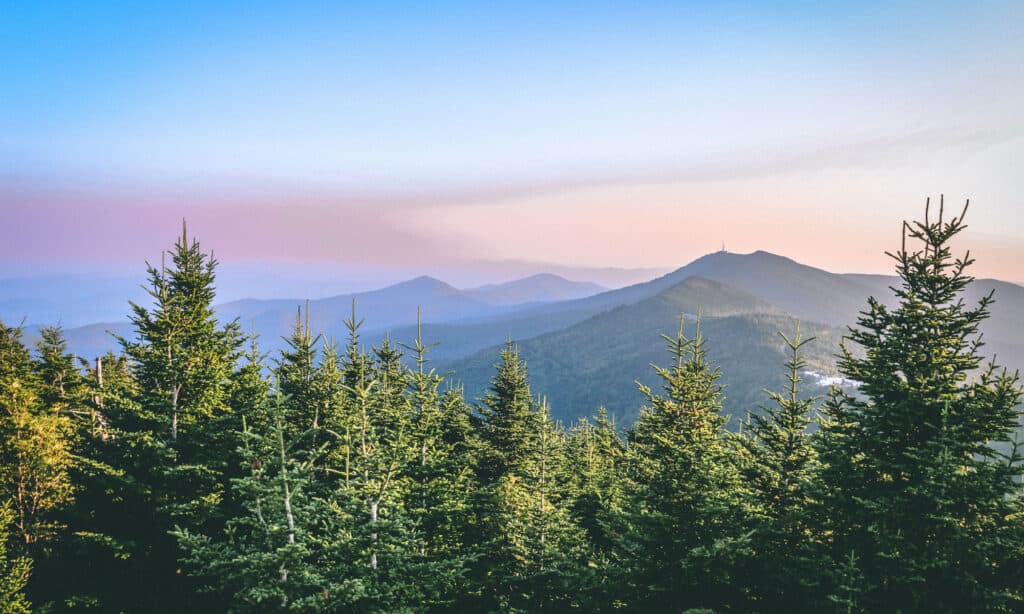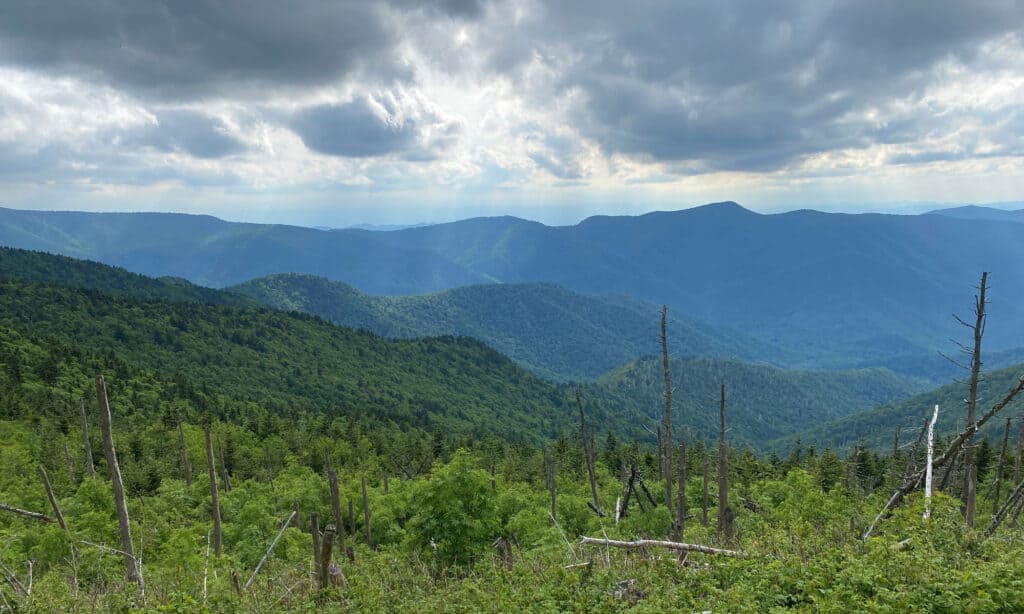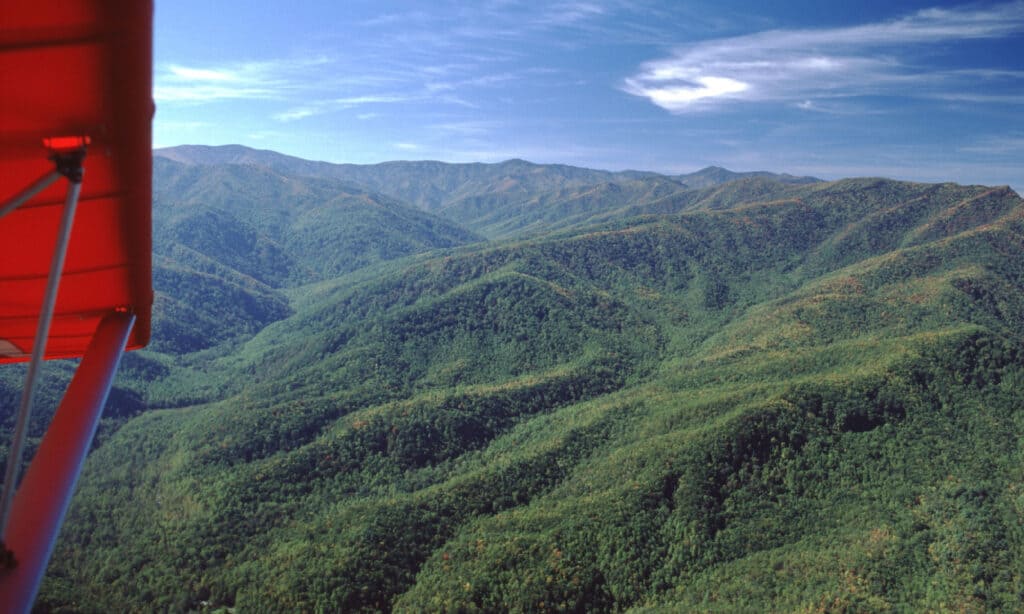Part of the Appalachian Mountains, the Blue Ridge Mountains feature some of the tallest and most beautiful mountains in North America. Time has made these old mountains a little less majestic than the snow-capped peaks of the Rockies or the Cascades. Still, the Blue Ridge Mountains have enchanted people for millennia with their beauty and the flora and fauna that call the mountains home. Their name is due to their hazy blue coloration when viewed from a distance. The color is caused by the isoprene, a volatile organic compound that the trees exhale into the air.

Though now far from the ocean, the mountains in this range are made of sediments washed in from an ocean that existed a billion years ago. Beneath these sediments is an underlayment of Thunderhead sandstone, which covers another layer of sandstone called the Roaring Fork layer. The Blue Ridge Mountains are home to black bears, bobcats, red and gray foxes, the northern flying squirrel, the pileated woodpecker, and wild turkeys. Mountain lions also used to roam these mountains, and there are those who claim they still do. Here are the five highest peaks in the Blue Ridge Mountains, from the tallest to the lowest.
Mount Mitchell

The Blue Ridge Mountains’ tallest peak is Mount Mitchell.
©iStock.com/Frederik Flagstad
At 6,684 feet, Mount Michell is the tallest mountain in the Blue Ridge Mountains. It’s also the tallest of the Appalachian Mountains, the tallest mountain in North Carolina, and the tallest mountain east of the Mississippi River. Found in Mount Mitchell State Park, it was named for Elisha Mitchell. He was an educator and minister who taught at the University of North Carolina. Mitchell explored and measured the mountain, then called Black Dome. He suffered a fatal fall from Mitchell Falls on the slope of the mountain named for him on June 27, 1857.
Not tall enough to be continually snowcapped, the top of Mount Mitchell bears forests of spruce and fir trees. This type of forest is only found in the southern part of the Appalachians. The bad news is that the elevation exposes these trees to acid rain and other types of pollution. You’ll see numbers of dead fir trees in the forests, even though the mountain is green and lush during the mild summers. Winters on the mountain are long and fairly cold. They resemble the winters of New Brunswick more than those of the North Carolina. The mountain also gets a good amount of precipitation in the form of rain and snow. Its summit tends to be windy.
Mount Craig

Mount Craig was named for a governor of North Carolina.
©Cody Flynn/Shutterstock.com
Found about a mile north of Mount Mitchell in North Carolina, Mount Craig is the second highest mountain in the Blue Ridge Mountains. It is 6,647 feet tall. Like Mount Mitchell it’s found in Mount Mitchell State Park, which is found within Pisgah National Forest. This mountain was named for Locke Craig, the North Carolina governor who established Mount Mitchell State Park.
To access Mount Craig, take the Deep Gap Trail found just below the top of Mount Mitchell. After a 45-minute hike you get to the summit of Mount Craig where you’ll be able to see the southern part of the Black Mountains. From the top of Mount Craig, you can hike to other peaks. These include Big Tom, Balsam Cone, Celo Knob, and Cattail Peak.
Clingmans Dome

Clingmans Dome is the highest point in Tennessee.
©iStock.com/Sam Fowler
At 6,643 feet, Clingmans Dome is the third highest point in the Blue Ridge Mountains. It’s also the tallest point in Great Smoky Mountains National Park, the highest mountain in Tennessee, and the highest point on the Appalachian Trail. Like Mount Mitchell, it’s covered by a forest of spruce and fir. Unfortunately, you’ll also see some dead trees due to an infestation of an insect pest. If you really want an experience, climb the observation tower, which is 45 feet tall and gives you a 360-degree view. On a clear day, you can see for about 100 miles around.
Commissary Ridge

You’ll find lots of beautiful trails on Commissary Ridge.
©Margaret.Wiktor/Shutterstock.com
The true height of North Carolina’s Commissary Ridge is a bit uncertain. The lowest estimation of its height, 6,640 feet, makes it number four in the top five highest peaks in the Blue Ridge Mountains. However, the highest estimation of 6,680 feet makes it number two behind Mount Mitchell. However tall this mountain is, it offers a number of scenic trails throughout Mount Mitchell State Park.
Mount Guyot

Beautiful Mount Guyot is somewhat challenging to access.
©iStock.com/Weber
Named after Arnold Guyot, a Swiss geologist, you’ll find this mountain on the border between Tennessee and North Carolina. It has two peaks, but the one in Tennessee is considered the summit at 6,621 feet high. It is also the home of a spruce and fir forest and the Ramsey Cascades. You’ll find this beautiful waterfall at the mountain’s western slope. The mountain was hard to access until the Civilian Conservation Corps built part of the Appalachian Trail along the same western slope during the Great Depression. The trail is joined by only one other, the Balsam Mountain Trail. Because of this, Mount Guyot is still a bit challenging to access.
The photo featured at the top of this post is © Film Adventure/Shutterstock.com
Thank you for reading! Have some feedback for us? Contact the AZ Animals editorial team.







